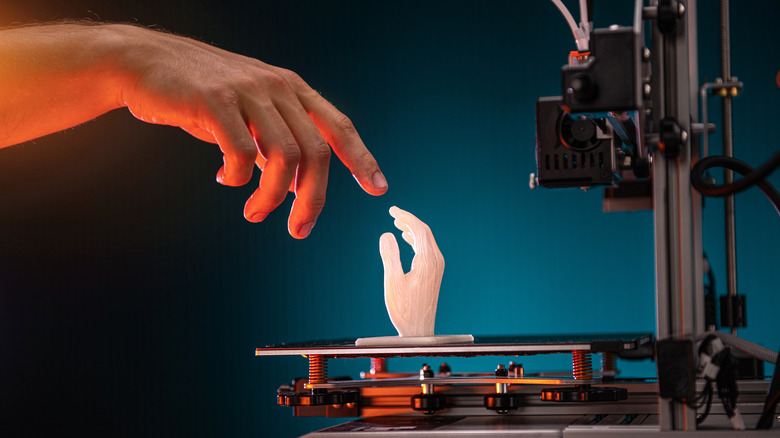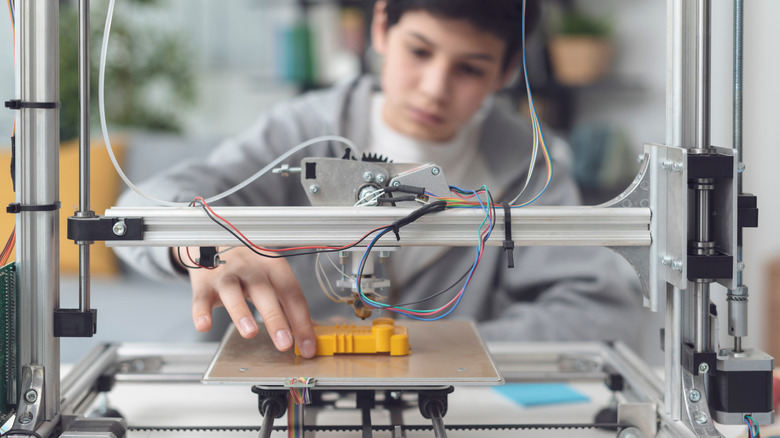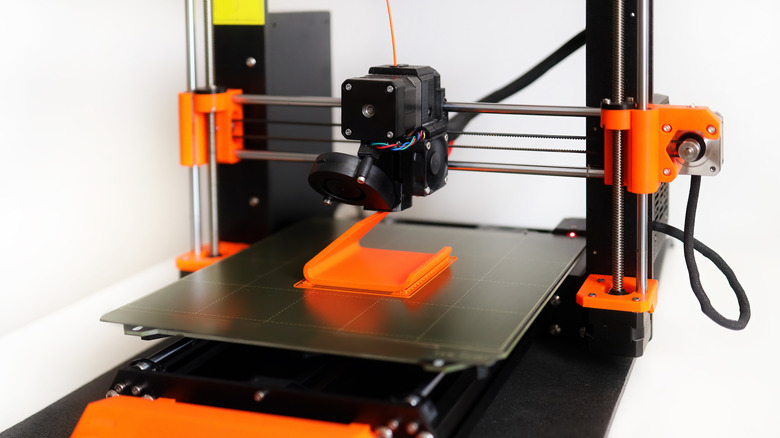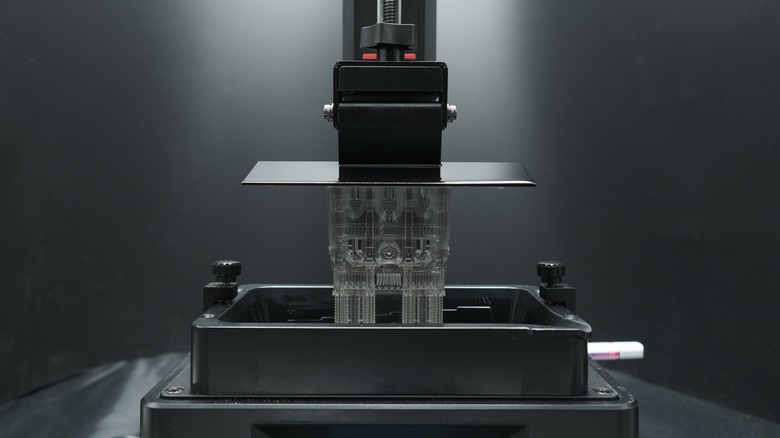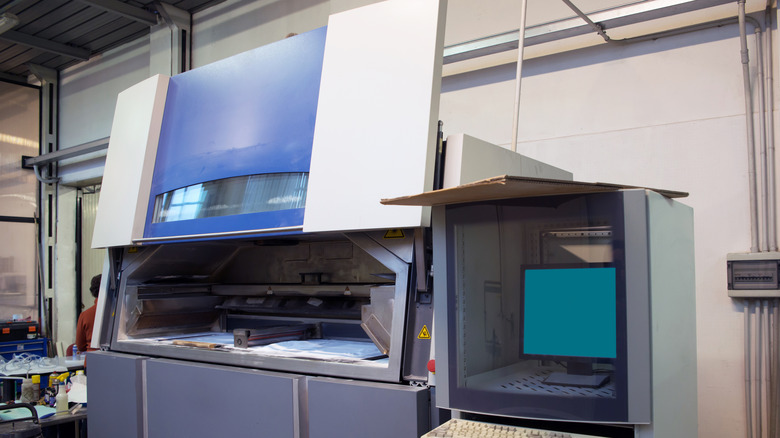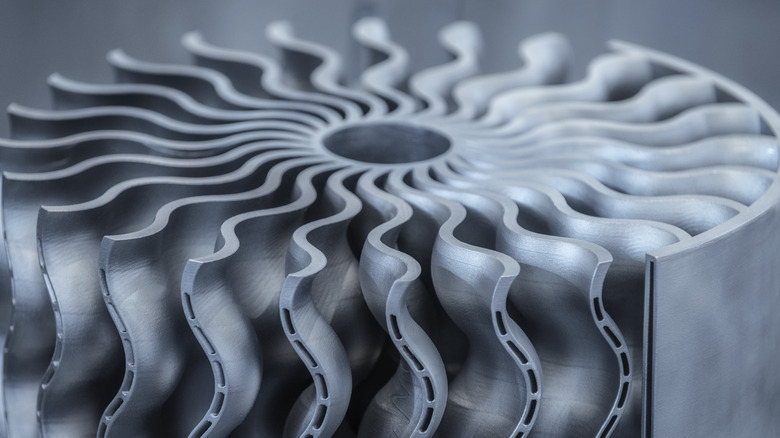Here's How 3D Printers Work
Perhaps one of the oldest dreams of a science-fiction future is the ability to create something where once there was nothing. If we could create solid, stable objects out of thin air, the idea of scarcity would be a thing of the past. Unfortunately, we haven't quite reached the level of the Replicator devices from "Star Trek," but that doesn't mean modern manufacturing devices are sitting on their proverbial laurels.
While it's not exactly making objects out of thin air, the practice of 3D printing has allowed for not just greater flexibility in manufacturing objects of various shapes and sizes, but also in the scale to which those objects are made. Anyone can own a 3D printer to craft their own constructs, where they create small standalone objects or components of something greater. It sounds like complicated super-science, but it's actually a fairly straightforward process once you understand how the various types of 3D printers work.
3D printing in general
The practice of 3D printing is known as "additive manufacturing." To give you a frame of reference, most manufacturing processes fall into either subtractive or formative manufacturing. Subtractive manufacturing is when you start with a big, solid block of some material and carefully shave it down into what you want, like a milling machine used to cut metal. Formative manufacturing is when the material is directly shaped and sculpted into what you want, like pouring molten plastic into a mold to make a doll.
So, what's additive manufacturing? As the name may imply, additive manufacturing is the opposite of subtractive manufacturing; rather than removing parts of the material, you add or alter the material in layers to create your desired object. The exact way you add the material, and in some cases, the material you're actually using, depends on the kind of 3D printing device you use.
Fused Deposition Modeling
Fused Deposition Modeling, or "FDM," is one of the most common 3D printer types for user-grade devices. This kind of technology is simple enough that it can be miniaturized and sold as a home appliance. The secret to FDM printing is thermoplastic filament, a thin strand of specially-made plastic highly receptive to temperature-based sculpting.
A filament thread is fed into the printer, where it's heated into a semi-solid state. As it enters this state, it passes through a temperature-controlled extrusion head, which carefully spits the plastic onto a printing surface. Utilizing your design specs, the plastic is carefully distributed and layered, stopping and starting to create gaps in the model. It's kind of like squeezing icing onto a cake in the shape of a rose, albeit on a much smaller and more precise scale.
The models created by this kind of printer may be a bit on the rough side, with visible lines between the layers. Even though the plastic is semi-solid, the individual strands can still have small gaps. This is why FDM printers are good for creating physical prototypes and proofs of concept.
Stereolithography
Stereolithography, or "SLA," was actually the very first type of 3D printing developed, dating as far back as the 1860s with the "photosculpture method" before being realized as a proper technology in the 1980s. SLA 3D printers utilize a kind of prototypical plastic called resin, which is selectively cured and hardened into a solid plastic shape.
The liquid resin used in this process is highly receptive to ultraviolet rays; all it takes is a brief exposure to a UV beam, which solidifies it. An SLA printer utilizes such a UV beam, firing off controlled bursts into a pool of resin in the shape of the object you want to make. As the beam fires, the resin solidifies, and the plastic mold is lifted up and out of the pool. Just wash off the excess gunk afterward, and there's your model.
Depending on the complexity of the model you're making and the specs of the SLA printer you're using, special support structures may be automatically hardened into the resin along with the mold itself to hold everything up. After the curing process, you can pluck the support structures right off. Thanks to the precision of the UV beam, this process can be used to make very geometrically complicated shapes, like a model of a human heart or an imprint of someone's teeth for making dentistry aids.
Selective Laser Sintering
While most forms of 3D printing utilize simple plastic in one form or another, not all of them do. For example, the process of selective laser sintering, or SLS, makes use of powdered polymers. You might not think a powder would be very conducive for crafting solid objects, but that's what the laser is for.
A large box of polymer powder is passed through a chamber, where it's selectively blasted with a high-powered laser. The spots on the powder that the laser hits are instantly bound together, layer by layer, creating a solid structure buried within the rest of the powder. Since it's all the same material, the structure is self-supporting while it's still buried, which is handy for crafting complicated shapes. Afterward, just blow off the excess powder, and you're done.
What's especially cool about SLS printing is that you can use more resilient materials than plain plastic. Nylon powder, for instance, is one of the most popular choices, as its models are lightweight, sturdy, and flexible. Rather than prototypes, you can actually create end-use mechanical parts with this method.
Industrial 3D Printers
As we mentioned before, one of the most cutting-edge elements of 3D printing is not just making objects from seemingly nothing but the scale at which you can do it. If you have a suitably sized printer and enough materials, you can use any 3D printing method to create objects of just about any size you can think of.
Industrial-sized 3D printers are already used for creating large-scale mechanical components, such as the various parts of a passenger-grade aircraft. Not only does 3D printing allow these components to be created much faster than traditional manufacturing methods, but they can be more easily crafted from lighter (yet no less resilient) materials. Lighter materials on a plane mean less burden on the engines, and less burden on the engines means less fuel consumption. 3D printing may not have the ability to conjure matter out of thin air, but it is one of many ways we're making crafting both more accessible and more economical.
